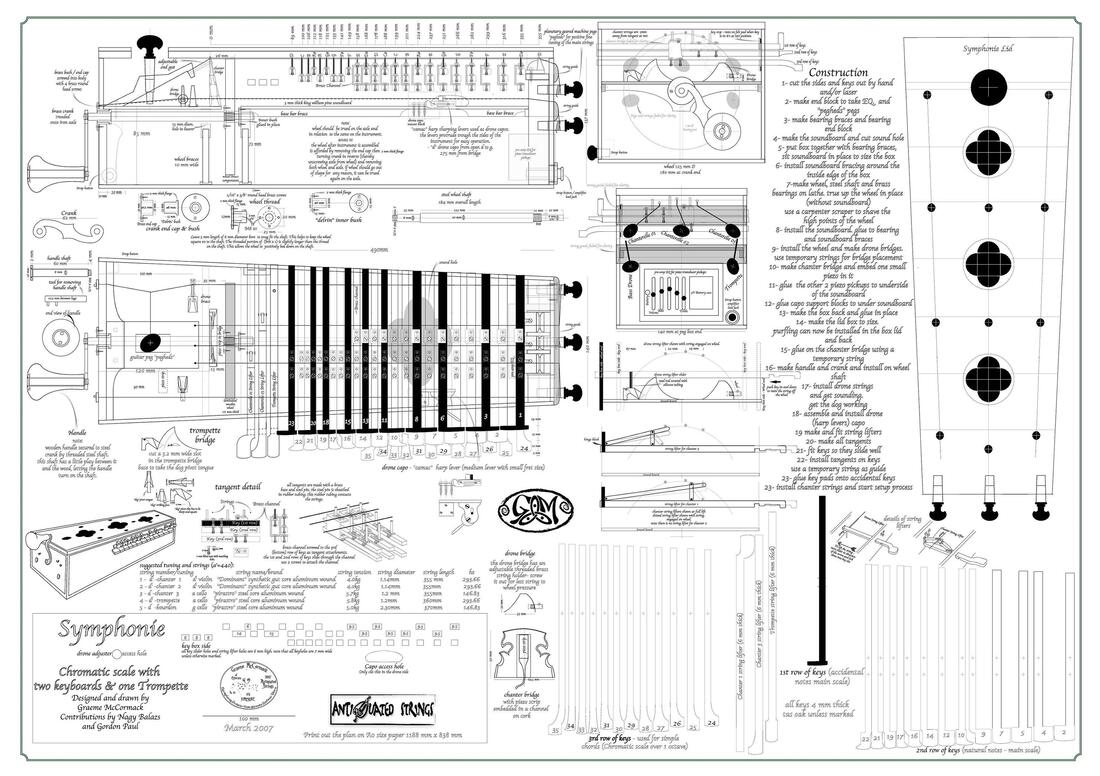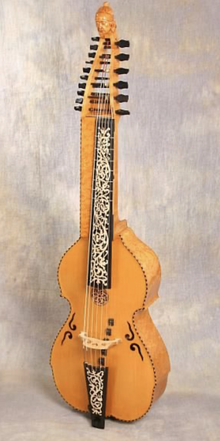 The hurdy-gurdy is generally thought to have originated from fiddles in either Europe or the Middle East some time before the eleventh century A.D.[2] One of the earliest forms of the hurdy-gurdy was the organistrum, a large instrument with a guitar-shaped body and a long neck in which the keys were set (covering one diatonic octave). The organistrum had a single melody string and two drone strings, which ran over a common bridge, and a relatively small wheel. Due to its size, the organistrum was played by two people, one of whom turned the crank while the other pulled the keys upward. Pulling keys upward is cumbersome, so only slow tunes could be played on the organistrum.[4] The pitches on the organistrum were set according to Pythagorean temperament and the instrument was primarily used in monastic and church settings to accompany choral music. Later on, the organistrum was made smaller to let a single player both turn the crank and work the keys. The solo organistrum was known from Spain and France, but was largely replaced by the symphonia, a small box-shaped version of the hurdy-gurdy with three strings and a diatonic keyboard. At about the same time, a new form of key pressed from beneath was developed. These keys were much more practical for faster music and easier to handle; eventually they completely replaced keys pulled up from above. Medieval depictions of the symphonia show both types of keys. During the Renaissance, the hurdy-gurdy was a very popular instrument (along with the bagpipe) and the characteristic form had a short neck and a boxy body with a curved tail end. It was around this time that buzzing bridges first appeared in illustrations. The buzzing bridge (commonly called the dog) is an asymmetrical bridge that rests under a drone string on the sound board. When the wheel is accelerated, one foot of the bridge lifts from the soundboard and vibrates, creating a buzzing sound. The buzzing bridge is thought to have been borrowed from the tromba marina (monochord), a bowed string instrument. The hurdy gurdy comes in when the percussive footwork comes in - its the neverending fiddlelike drone. The sound is somewhere between pipes and fiddle. the fiddle comes in later  Theorbo' is an anglicized form of the Italian word 'tiorba', which was a colloquial name for a large instrument of the lute family. It was developed in Florence during the 1580s. The instrument was known initially by its formal academic name 'chitarrone', derived from the Greek 'kythara'. 'Tiorba' was only used initially in informal contexts, but by the middle of the 17th century, it had completely usurped 'chitarrone' as the normal name in everyday use.  There are only about 50 historical barytons for which we have evidence, either in the form of documents or the instrument itself. Many of the latter have been modified from their original form. Thus, tracing the history of the baryton is a difficult task.[3] Concerning the origin of the baryton, the instrument probably originated in England in the early 17th century when the characteristics of two instruments, the viola da gamba and the bandora, were combined into one hybrid instrument".[4] Early evidence for the existence of the baryton is found circa (1644). The instrument had six bowed strings as well as metal strings behind the neck. The thumb of the left hand plucked the metal strings, which were made to sound with the bowed notes. If this information is accurate, the baryton must have been known in England before 1625, the end of King James' reign."[5] The earliest baryton that survives today dates from 1647; it was made by Magnus Feldlen in Vienna and is currently in the musical instrument collection of the Royal College of Music in London.[6 The instrument was never particularly popular, but "it acquired a certain cachet in courtly circles, particularly in south Germany and Austria". The compositions for the instrument by Haydn and his students and colleagues represented a last hurrah for the baryton; by the early 19th century it had gone out of style and ceased to attract new compositions.[8] The Haydn-era baryton was different from earlier versions in a crucial respect: the sympathetic strings were tuned a full octave higher than previously. This helped the baryton to stand out from the other instruments (viola, cello) in the baryton trio,[9] Uilleann pipes The first bagpipes to be well attested for Ireland were similar, if not identical, to the Scottish Highland bagpipes that are now played in Scotland. The union or uilleann pipe emerged during the early 18th century and were far quieter and sweeter in tone than their mouth-blown predecessors. Essentially their design required the joining of a bellows under the right arm, which pumped air via a tube to a leather bag under the left arm, which in turn supplied air at a constant pressure to the chanter and the drones (and regulators in the case of the Irish Uilleann pipes). The earliest surviving sets of uilleann pipes date from the second half of the 18th century, but it must be said that datings are not definitive. The Uilleann pipes were often used by the Protestant clergy, who employed them as an alternative to the church organ.[citation needed] As late as the 19th century the instrument was still commonly associated with the Anglo-Irish, e.g. the Anglican clergyman Canon James Goodman (1828–1896) from Kerry, who had his tailor-made uilleann pipes buried with him at Creagh (Church of Ireland) cemetery near Baltimore, County Cork. His friend, and Trinity College colleague, John Hingston from Skibbereen also played the uilleann pipes. Another piping friend of Canon Goodman, Alderman Phair of Cork (founder of the pipers club in Cork in the 1890s) had Goodman's pipes recovered from Creagh cemetery. They were later donated to Cork piper Michael O'Riabhaigh, who had re-established the (by then extinct) pipers club in Cork in the 1960s.
1 Comment
|
What do we do?Join us to be inspired by music from around the world, no preparation, prerequisites, or practicing required. I’ll read a short composer bio, highlight some historically relevant material or interesting context, we’ll listen to a piece of music, and then take the time to reflect on what we heard, ask questions, and explore. Archives
March 2021
Categories |

 RSS Feed
RSS Feed